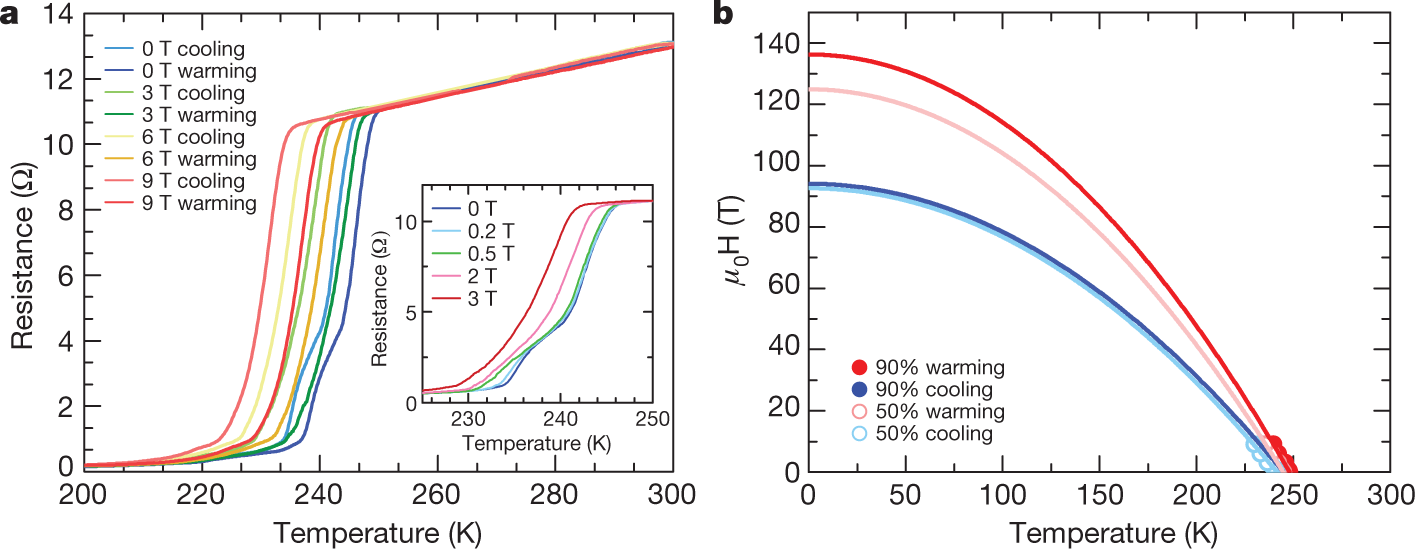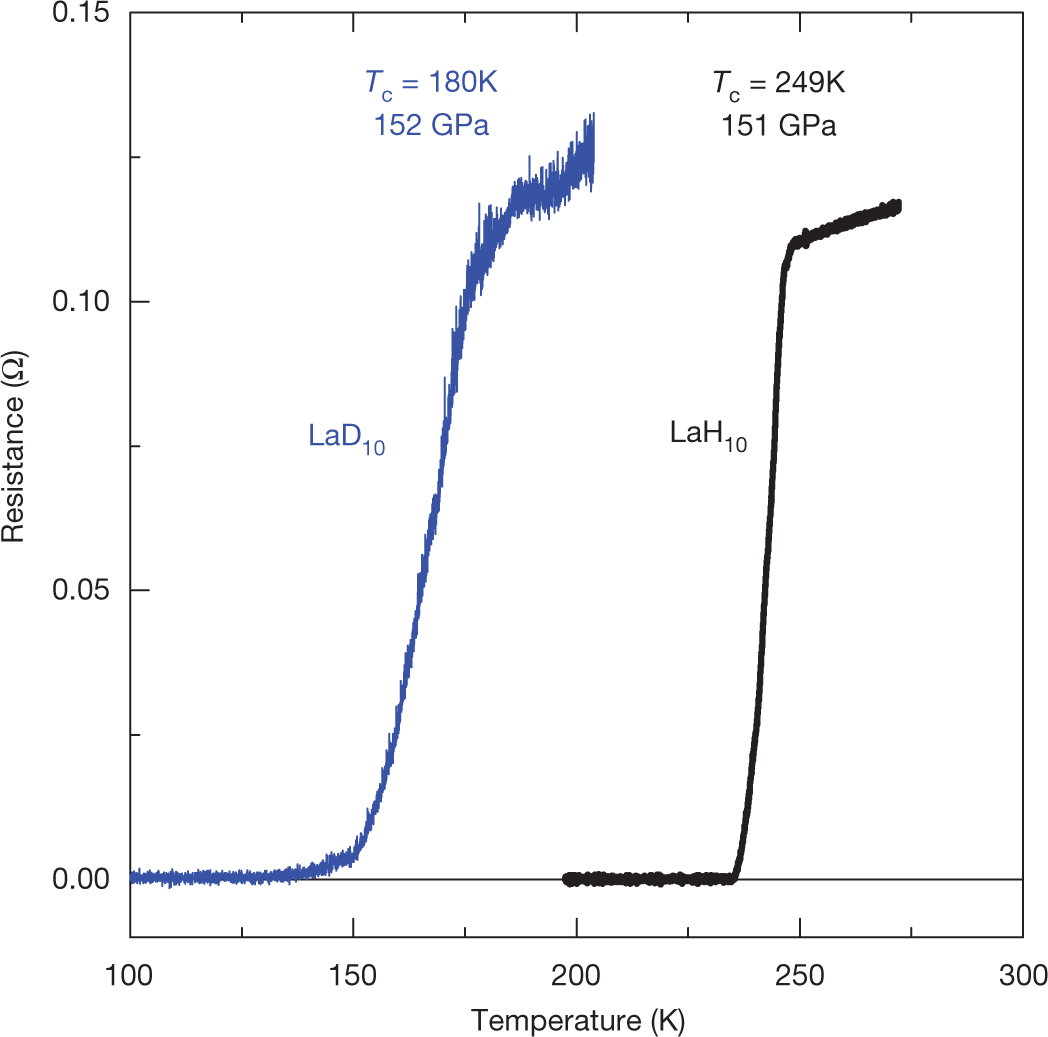Superconductivity Observed at 250K, (-23C).
The paper I'll discuss in this post is this one: Superconductivity at 250 K in lanthanum hydride under high pressures (M. I. Eremets et al, Nature Nature 569, 528–531 (2019).
Superconductivity, as most people know, is a property of a material to conduct electricity without losing energy. Many commercial instruments exploiting superconductivity are known; the most familiar to most people are MRI (Magnetic Resonance Instruments) medical diagnostic devices, descendants of the NMR (nuclear magnetic resonance), with the word "nuclear" having been dropped from the name as a genuflection of fear of fear and ignorance with respect to the word "nuclear."
In MRI devices in use today, the superconductive wire utilized is an alloy of niobium and titanium, the former being a "conflict" metal often mined by enslaved children as the mineral "coltan," reflecting a historical name for the element niobium, "columbium," as well as the other constituent, used in cell phones, “tantalum.” “Columbium” was ultimately rejected by the IUPAC as a name for niobium. To achieve superconductivity in niobium/tantanlum alloy, it is necessary to bathe the wire in liquid helium, with the liquid helium itself being bathed in liquid nitrogen.
As noted in this space elsewhere by another correspondent, all of the helium on earth, when released into the atmosphere, ultimately boils off into space as a consequence of the relatively weak gravitational field of the earth compared to Jupiter and Saturn, because, as one can learn by playing with the Maxwell-Boltzmann equation, a significant portion of helium molecules have velocities at normal temperatures exceeding the escape velocity of Earth, 11.2 km/sec, these velocities being a function of atomic or molecular weight with respect to the internal energy represented by temperature.
The current availability of helium is the result of helium trapped in rocks and produced by the decay of uranium (and to a lesser extent, thorium) and their daughters in the Earth's crust. It is generally obtained from dangerous natural gas wells.
Superconductivity at temperatures corresponding to the temperature of liquid nitrogen are known, and have been known for some time, however the superconductive materials are ceramics which cannot be drawn into wire, and are only able to carry limited amounts of current.
While the lanthanum hydride investigated in this study is unlikely to have practical use - I say this in lieu of hearing once again how wind turbines in North Dakota "could" power New York - it does help establish a basis for the discovery of new superconductive materials.
From the text:
The quest for room-temperature superconductivity is longstanding challenge. Until 1986, superconductivity was considered to be a low-temperature phenomenon, as all known superconducting materials possessed critical temperatures (Tc) below about 30 K. However, the discovery of the cuprate superconductors7—copper-based materials with Tc values as high as 164 K (ref. 8), known as the high-temperature superconductors—initiated extensive research in an attempt to obtain superconductivity at room temperature. However, despite considerable efforts, the maximum value of Tc remained the same for the next 25 years.
The discovery of superconductivity at 203 K in H3S1 at high pressures offered another route in the search for high-temperature superconductivity in conventional superconductors9. It provided the first confirmation of the predictions of the Bardeen–Cooper–Schrieffer and Migdal–Eliashberg theories regarding the possibility of high-temperature superconductivity in materials with high phonon frequencies10. In principle, hydrogen- and carbon-abundant materials can provide the required high frequencies in the phonon spectrum as well as a strong electron–phonon interaction11,12. Advances in the experimental search for room-temperature superconductivity came from crystal-structure predictions based on density functional theory13,14,15,16: the electron and phonon spectra as well as the transition temperatures can be estimated from density functional and Migdal–Eliashberg theories. First-principles theories of superconductivity are also progressing17,18. At present, nearly all of the binary hydrides have been studied theoretically13,14,15, and calculations are now focusing on the ternary compounds19.
Some pictures from the text:

The caption:
Superconducting transitions in the lanthanum superhydride LaH10, measured in different samples synthesized from a La + H2 mixture. Red curve, sample heated at 145 GPa with Tc ? 244 K, which shifts to around 249 K when the pressure is increased to 151 GPa (orange curve, sample 1); dark yellow curve, sample heated at 135 GPa with Tc ? 243 K (sample 2); blue curve, sample heated at 150 GPa with Tc ? 249 K (sample 3). The red, orange and dark yellow curves show the sharpest transitions to zero resistance upon cooling or heating. The blue curve of sample 3—as is also the case for many other samples—shows an onset of the superconductive transition at around the same temperature, but the sharp transition is distorted by the presence of an impurity phase and/or inhomogeneity in the sample. For clarity, the resistance of the samples was divided by the coefficients shown. The black vertical line at 290 K marks the room-temperature superconductivity (RTSC) limit. The inset shows the dependence of the critical temperature Tc on pressure; the seven different samples are marked in different colours (orange, dark yellow, blue, green, red, magenta and black points correspond to samples 1, 2, 3, 4, 5, 6 and 7, respectively; see Supplementary Table 1). The vertical and horizontal error bars correspond to the uncertainty in the determination of the correct value of Tc (that is, criteria-dependent) and in the precise value of the pressure (inherent error bars of the method used), respectively.

The caption:
a, Electrical resistance as a function of temperature for LaH10 (sample 3) under applied magnetic fields of up to 9 T. The width of the superconducting transition remains essentially constant up to 9 T. Both the cooling and the heating temperature sweeps are plotted. The superconducting critical temperatures were determined as the average of the two sweeps. An applied field of 9 T reduces the onset of the superconducting transition from around 250 K (as extracted from the heating curve) to around 240 K. It is notable that the step observed in the superconducting transition measured at zero field, which appears around 245 K, disappears under the application of a modest field of just 3 T (inset); this step probably results from inhomogeneities in the superconducting sample. Similar behaviour was found in disordered superconducting diamond doped with boron25. b, Upper critical fields as a function of temperature following the criteria of 90% (solid markers) and 50% (open markers) of the resistance in the metallic state, characterized by predominantly linear temperature dependence above Tc. Solid curves are extrapolations resulting from fits to the Ginzburg–Landau expression in order to estimate the upper critical fields at the zero-temperature limit. The temperature dependence of the observed upper critical fields was obtained from the data displayed in Fig. 2a. The upper critical fields near the critical temperature increase nearly linearly with the decrease in temperature. Here, we use a simple Ginzburg–Landau expression ) to estimate the upper critical fields Hc2(0) in the limit of zero temperature. The Ginzburg–Landau coherence lengths (?

deduced from these Hc2(0) values range between 1.56 and 1.86 nm.

X-ray diffraction studies of superconducting lanthanum hydrides. a, Cake representation of the typical X-ray powder diffraction pattern measured for the sample with Tc ? 249 K at 150 GPa (sample 3). The dominant face-centred Fm3¯m phase gives a spotty powder pattern. b, c, Integrated powder patterns for samples synthesized from the La + H2 mixture with Tc ? 249 K at 150 GPa (sample 3) (b) and the La + D2 mixture with Tc ? 140 K at 142 GPa (sample 8) (c). Indexation and refinement of these powder diffraction patterns yields two different phases: Fm3¯m (a = 5.1019(5) Å, V = 132.80(4) Å3) and P4/nmm (a = 3.7258(6) Å, c = 5.0953(12) Å, V = 70.73(2) Å3) with stoichiometries corresponding to LaH9.6 and LaD10.6, respectively. Both refined crystal structure models are in good agreement with the predicted structures for LaH10 (refs 4,5) and LaH11 (ref. 3), except for the reflection at around 6.10° in c that relates to the most intensive 101 reflection of the impurity hcp-I phase. The black, red and blue traces correspond to the experimental data, the fitted data, and the difference between experimental and fitted data, respectively. a.u., arbitrary units. The Le Bail fitting method was chosen to extract the intensities from the powder diffraction pattern, because it is impossible to extract the real intensities of the reflections from the spotty patterns. d, e, The distribution of the main superconducting LaH10 Fm3¯m (d) and LaD11 P4/nmm (e) phases in the samples. The contribution of these phases is estimated using the integral intensity arising from the corresponding phase in the overall powder pattern. These phases comprise more than 80% of the samples, and their distribution throughout the samples is very smooth.

The caption:
The superconductive transition shifts to markedly lower temperatures after hydrogen is replaced by deuterium in samples with the same fcc crystal structure. The black curve corresponds to LaH10 (sample 1) and the blue curve corresponds to LaD10 (sample 17).
Summary conclusions:
In summary, we report the superconductivity of LaH10 with a critical temperature of 250 K; to our knowledge, this is the highest critical temperature reported in a superconducting material. We experimentally confirm the prediction of high-temperature superconductivity in superhydrides with a sodalite clathrate-like structure, which was first proposed for CaH6 (ref. 2). Our study is a further advance towards room-temperature superconductivity, and also provides evidence that state-of-the-art methods for the prediction of crystal structures can be very useful in the search for high-temperature superconductors. The current theoretical predictions for room-temperature superconductivity in yttrium superhydrides3,5,26 motivate further experiments. The observation of superconductivity with very high critical temperatures at high pressures is expected to generate further interest in the search for high-temperature superconductivity at ambient pressure, for example in carbon-based materials11. One encouraging example is the discovery of superconductivity at a critical temperature of around 55 K in Q-carbon27.
We may not be aware of this, but the use of superconductive materials influences our lives.
I trust you're enjoying the holiday weekend.



